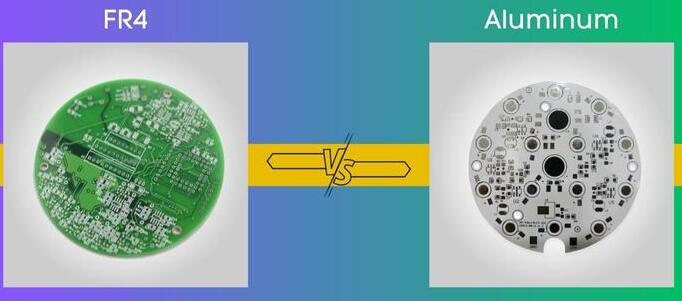Aluminum substrate is a metal-based copper-clad plate with good heat dissipation function. Generally, a single panel is composed of a three-layer structure, which is a circuit layer (copper foil), an insulation layer, and a metal substrate. Commonly seen in LED lighting products. There are two sides, the white side is for welding LED pins, and the other side is in aluminum color. It usually comes into contact with the thermal conductive part after applying the thermal conductive paste. At present, there are also ceramic substrates and so on.

PCB board generally refers to printed circuit boards. Printed Circuit Board (PCB), also known as Printed Circuit Board, is a provider of electrical connections for electronic components. Its development has a history of over 100 years; Its design mainly focuses on layout design; The main advantage of using circuit boards is greatly reducing wiring and assembly errors, and improving automation levels and production labor rates.
Aluminum substrate vs Printed circuit board
These two substrates, which look very similar on the surface, actually have many obvious differences, such as:
1. From a technical perspective, aluminum substrates are made from aluminum-based materials, characterized by good thermal conductivity and oxidation resistance, making them suitable for high-power electronic devices. PCB board, on the other hand, refers to the printed circuit board, which is assembled electronically by covering one or more layers of insulating substrate with a layer of conductive metal and forming corresponding circuit patterns on its surface. It is suitable for small size, lightweight, and high-reliability requirements of electronic products.
2. From a process perspective, the production process of aluminum substrates is relatively simple, and most of them are processed using drilling technology, resulting in lower production costs. PCB boards, on the other hand, require complex processes such as drawing circuit patterns and forming conductive layers on the substrate through chemical reactions or lithography techniques, resulting in higher production costs.
3. From a usage perspective, aluminum substrates are suitable for high-power heating devices, optoelectronic modules, mechanical devices, automotive electronics, and other fields. Their main advantages are high reliability and good heat dissipation. PCB boardsare suitable for computer peripherals, communication devices, laptops, consumer electronics, and other fields. Their main advantages are high manufacturing accuracy, high space utilization, and unrestricted shape. It can be said that aluminum substrates and PCB boards each have unique advantages in different scenarios.
4. Currently, aluminum-based PCB boards on the market are generally single-sided aluminum substrates, and there are many types of PCB boards. Aluminum substrates are just one type of PCB board, belonging to the aluminum alloy board. Due to their good thermal conductivity, they are generally used in the LED industry.
5. PCB boards are generally made of copper, which can be divided into single board and double board. There is a significant difference in the materials used for these two types of boards. The aluminum substrate is mainly aluminum, while the PCB board is mainly copper. In terms of heat dissipation, aluminum substrate has better performance than PCB board, and its thermal conductivity is also different from PCB board. The aluminum substrate is a type of PCB, and the price of the aluminum substrate is relatively expensive.
Aluminum substrate and PCB board are two very common substrates that play important roles in circuit boards.